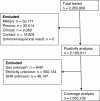Do sexual health campaigns work? An outcome evaluation of a media campaign to increase chlamydia testing among young people aged 15-24 in England
- PMID: 23683345
- PMCID: PMC3671151
- DOI: 10.1186/1471-2458-13-484
Do sexual health campaigns work? An outcome evaluation of a media campaign to increase chlamydia testing among young people aged 15-24 in England
Abstract
Background: A national multimedia campaign was launched in January 2010, to increase the proportion of young people tested for chlamydia. This study aimed to evaluate the impact of the campaign on the coverage and positivity within the National Chlamydia Screening Programme (NSCP) in England.
Method: An interrupted time series of anonymised NCSP testing reports for England for a 27 month period (1st April 2008 to 30th June 2010) was analysed. Reports were assigned to a pre-campaign, campaign and post campaign phase according to the test date. Exclusion criteria included tests for clinical reasons, contacts of known cases, and tests returned from prisons or military services.Negative binomial and logistic regression modelling was used to provide an estimate for the change in coverage and positivity, during, and after the campaign and estimates were adjusted for secular and cyclical trends.
Results: Adjusting for cyclical and secular trends, there was no change in the overall testing coverage either during (RR: 0.91; 95% CI: 0.72-1.14) or after (RR: 0.88; 95%CI: 0.69-1.11) the campaign. The coverage varied amongst different socio-demographic groups, testing of men increased during the campaign phase while testing of people of black and other ethnic groups fell in this phase. The positivity rate was increased during the campaign (OR: 1.18; 95% CI 1.13-1.23) and further increased in the post-campaign phase (OR: 1.40; 95% CI 1.30-1.51). The proportion of chlamydia infections detected increased for all socio-demographic and self-reported sexual behaviour groups both during and after the campaign.
Conclusion: The uptake of chlamydia testing rose during the campaign; however, this apparent increase was not maintained once overall trends in testing were taken into account. Nonetheless, once secular and cyclical trends were controlled for, the campaign was associated with an increased positivity linked to increased testing of high risk individuals groups in the target population who were previously less likely to come forward for testing. However, our study indicated that there may have been a disparity in the impact of the campaign on different population groups. The content and delivery of ongoing and future information campaigns aimed at increasing chlamydia screening should be carefully developed so that they are relevant to all sections of the target population.
Figures
Similar articles
-
What is the effectiveness of community-based health promotion campaigns on chlamydia screening uptake in young people and what barriers and facilitators have been identified? A mixed-methods systematic review.Sex Transm Infect. 2022 Feb;98(1):62-69. doi: 10.1136/sextrans-2021-055142. Epub 2021 Aug 26. Sex Transm Infect. 2022. PMID: 34446545 Free PMC article.
-
Will chlamydia screening reach young people in deprived areas in England? Baseline analysis of the English National Chlamydia Screening Programme delivery in 2008.Sex Transm Dis. 2011 Aug;38(8):677-84. doi: 10.1097/OLQ.0b013e31821597ca. Sex Transm Dis. 2011. PMID: 21844718
-
Internet testing for Chlamydia trachomatis in England, 2006 to 2010.BMC Public Health. 2012 Dec 19;12:1095. doi: 10.1186/1471-2458-12-1095. BMC Public Health. 2012. PMID: 23253518 Free PMC article.
-
Evidence for the effectiveness of a chlamydia awareness campaign: increased population rates of chlamydia testing and detection.Int J STD AIDS. 2007 Apr;18(4):239-43. doi: 10.1258/095646207780658854. Int J STD AIDS. 2007. PMID: 17509173
-
Epidemiological, social, diagnostic and economic evaluation of population screening for genital chlamydial infection.Health Technol Assess. 2007 Mar;11(8):iii-iv, ix-xii, 1-165. doi: 10.3310/hta11080. Health Technol Assess. 2007. PMID: 17311735 Review.
Cited by
-
Impact of a pay-for-performance scheme for long-acting reversible contraceptive (LARC) advice on contraceptive uptake and abortion in British primary care: An interrupted time series study.PLoS Med. 2020 Sep 14;17(9):e1003333. doi: 10.1371/journal.pmed.1003333. eCollection 2020 Sep. PLoS Med. 2020. PMID: 32925909 Free PMC article.
-
Social marketing and mass media interventions to increase sexually transmissible infections (STIs) testing among young people: social marketing and visual design component analysis.BMC Public Health. 2024 Feb 26;24(1):620. doi: 10.1186/s12889-024-18095-8. BMC Public Health. 2024. PMID: 38408945 Free PMC article.
-
Would you tell everyone this? Facebook conversations as health promotion interventions.J Med Internet Res. 2014 Apr 11;16(4):e108. doi: 10.2196/jmir.3231. J Med Internet Res. 2014. PMID: 24727742 Free PMC article.
-
What is the effectiveness of community-based health promotion campaigns on chlamydia screening uptake in young people and what barriers and facilitators have been identified? A mixed-methods systematic review.Sex Transm Infect. 2022 Feb;98(1):62-69. doi: 10.1136/sextrans-2021-055142. Epub 2021 Aug 26. Sex Transm Infect. 2022. PMID: 34446545 Free PMC article.
References
-
- National Chlamydia Screening Steering Group. New Frontiers: Annual Report of the National Chlamydia Screening Programme in England 2005/06. London; 2006.
-
- National Chlamydia Screening Programm. NHS Vital Signs 2010/11: Primary Care Trust (PCT) and Strategic Health Authority (SHA) specific tables, 1st April 2010 to 31st March 2011. London. 2011. http://www.chlamydiascreening.nhs.uk/ps/assets/pdfs/data/VSI_PCT/VSI_by_....
MeSH terms
LinkOut - more resources
Full Text Sources
Other Literature Sources
Medical
Miscellaneous



